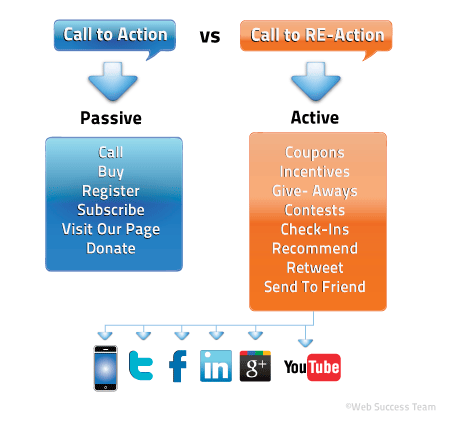29
Sep 2011
Call to Re-Action: How to Engage Your Audience on a Deeper Level
By Janette Speyer and Alison Brown – Web Success Team
A call-to-action is a common online marketing tactic used by marketing experts to urge people to engage with a product or service. Social media marketing advertisements that don’t display a call-to-action are often considered incomplete and ineffective because you aren’t asking customers to connect with you. While this passive approach has been effective in the past, what is even more effective is something called a “call-to-reaction.” It allows you to engage your audience on a deeper level, and gives them an incentive to connect with you immediately.

Direct vs. Passive Approaches
The difference between a call-to-action and a call-to-reaction is that a call-to-action is a less direct approach, such as saying “call us” or “follow us,” while a call-to-reaction asks you to engage right away. For instance on Facebook, if you ask someone to like your page to get a 20% discount, then you are giving the visitor a good incentive to engage, or to react. It entices people to go a step further, and gives them a good reason to get involved. Then once they like your page, they gain visibility to your posts, and have a stronger connection to your business.
Engagement Strategy
A call-to-reaction is a great way to engage people and get them interested in your company’s products or services. With a little help from technology, you can easily measure online engagement and see how effective your online marketing campaign is. You can see who is reacting to your sales pitch on Facebook by using their open graph technology. It allows you to analyze trends and provides you with insight into how many people clicked on the links you posted. The more clicks you have, the more interest and “reaction” you’ve created.
Social Media Reactions
Another example of an engagement reaction is a re-tweet on Twitter. If someone re-tweets something that you shared, then you have given that follower enough motivation to react and share information you’ve given them. The same thing goes for LinkedIn, and Facebook, if someone re-shares something that you’ve posted, then you have successfully engaged that reader on a deeper level. They aren’t just following you, they are engaging with you.
Cutting Edge Engagement
In the past, if you saw a billboard on the freeway, it would have been placed there based on the traffic that passes by, but now you have to vamp up your marketing efforts to get the most out of your buck. Mobile applications are a great way to do this, and it takes engagement reaction to another level. Mobile application “Foursquare,” has been used to successfully engage people by combining billboards with mobile applications. Recently in the San Francisco Bay Area, an environmental organization called Earthjustice used Foursquare to leverage support for their cause. They posted a billboard at a popular train station that asked commuters to “check in” at that location on Foursquare so that they could help save an endangered species. A donor offered to donate $10 for every check-in, and that billboard alone enticed over 6,000 commuters to support the cause.
Why Should I Care?
People respond better to your business when you give them a reason to react. After all, you have to give them a reason to be interested in what you’re saying. With the use of cutting edge engagement tools such as Facebook’s open graph technology, as well as Google Analytics, you can determine how engaging your marketing strategy is. It’s never been easier to ensure that your marketing campaigns are effective, and that they’re generating leads. These tools can help you make sure that you are not only reaching out to the right demographic, but that people are taking action because of your advertisements. The more insight you are able to cultivate, the better your chances are for expanding business and getting to where you want to be.
What’s Your Re-Action?
This article won’t make much sense unless we asked for our readers’ re-actions. We welcome your comments, re-tweets and shares!
If you liked this article you may also like:












September 29th, 2011 20:46 /
So well articulated & easy to understand. Nicely done!
October 1st, 2011 10:45 /
WST,
Like the use of the term “Call to Re-Action” very much.
In a perfect world, the action or reaction is a knee-jerk reflex, stopping people in their tracks and gets them engaging.
October 3rd, 2011 14:00 /
Thanks for the input @jdgershbein. Always glad to hear from you 🙂